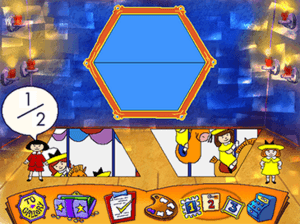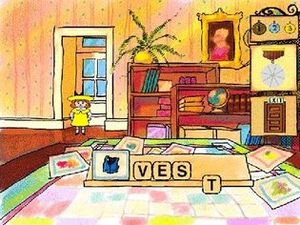Madeline (video game series) facts for kids
Quick facts for kids Madeline |
|
|---|---|

Series logo
|
|
| Genres | Educational, adventure |
| Developer | Vortex Media Arts |
| Publishers | Creative Wonders (ABC/EA 1995–1997) (The Learning Company 1998) (Mattel Interactive 1999) |
| Creators | Ludwig Bemelmans (franchise) Greg Bestick (video games) |
| Artists | Laurie Bauman (original design) Annie Fox (original design) |
| Platforms | Microsoft Windows, Mac OS |
| First release | Madeline and the Magnificent Puppet Show: A Learning Journey
|
| Latest release | Madeline 1st and 2nd Grade Math
|
The Madeline video games are a series of educational adventure games. They were made in the mid-1990s for computers like Windows and Mac. These games are based on the popular Madeline children's books by Ludwig Bemelmans. The books tell stories about a brave young French girl named Madeline. The games came out around the same time as the Madeline TV show. Many characters and voice actors from the show were also in the games.
In each game, Madeline helps players learn through fun mini-games. These activities teach things like reading, math, and problem-solving. Players can also learn basic French and Spanish words. Some games even teach about different cultures. Each game focuses on a different school subject. Most games take place at Madeline's boarding school in Paris, France. But some games also let you explore other European countries.
The idea for the series came from Greg Bestick, who was the president of Creative Wonders. Vortex Media Arts developed the games. The goal was to create educational games for young girls. They wanted to use a character that kids already knew and loved. Game creators talked to teachers, parents, and children while making the games. The first game, Madeline and the Magnificent Puppet Show: A Learning Journey, came out in 1995. This was at the same time as The New Adventures of Madeline TV show. The series has eight main games and two collections.
Companies like Creative Wonders, The Learning Company (formerly SoftKey), and Mattel Interactive published the games. They worked with DIC Entertainment, which owned the rights to the games and TV show. Creative Wonders and The Learning Company did many promotions for the games. The series was very successful and sold well. Many critics liked the games for their focus on learning and their animation style. In 1998, The Learning Company bought Creative Wonders. The series stopped being made in 1999. This happened as demand for children's point-and-click games went down.
Contents
Discover the Madeline Games
| 1995 | |
|---|---|
| Madeline and the Magnificent Puppet Show: A Learning Journey | |
| 1996 | |
| Madeline Thinking Games | |
| Madeline European Adventures | |
| 1997 | |
| Madeline Classroom Companion: Preschool and Kindergarten | |
| Madeline Classroom Companion: 1st and 2nd Grade | |
| 1998 | Madeline Thinking Games Deluxe |
| Madeline Rainy Day Activities | |
| Madeline 1st and 2nd Grade Reading | |
| Madeline 1st & 2nd Grade Reading Deluxe | |
| 1999 | |
| Madeline 1st and 2nd Grade Math | |
Madeline and the Magnificent Puppet Show: A Learning Journey was the first game. It came out to help promote The New Adventures of Madeline TV show. In this game, Madeline is in Paris. She helps organize a puppet show to save her neighbor's home.
The second game was Madeline Thinking Games. Here, Madeline invites players to explore her boarding school. They can play many educational mini-games in the rooms and gardens. Next came Madeline European Adventures, also called Madeline European Vacation. In this game, Madeline travels to places like Zermatt, Venice, and Istanbul. She is trying to find a man who stole a magic lamp.
Madeline Classroom Companion: 1st and 2nd Grade was part of a series for kids aged four to eight. This game lets Madeline guide players on a tour of her Paris neighborhood. Madeline Thinking Games Deluxe combined Madeline Thinking Games and Madeline European Adventures. The sixth game, Madeline Rainy Day Activities, is set at Madeline's school. Players help Madeline find things to do on a rainy day.
Madeline 1st and 2nd Grade Reading also takes place at the boarding school. Madeline helps players with reading activities. These include crossword puzzles and finding synonyms. From a magic attic, players can even visit a carnival in Venice or Egyptian pyramids. This game was later re-released as Madeline: 1st and 2nd Grade Reading Deluxe.
Madeline Classroom Companion: Preschool and Kindergarten was another game for young children. Like the other "Classroom Companion" games, it takes players on a tour of Madeline's neighborhood.
The last game in the series was Madeline 1st and 2nd Grade Math. It came out on July 12, 1999, as a two-CD-ROM set. The discs were also sold separately. This game is set in famous art museums like the Louvre and the Musée d'Orsay. Madeline guides players through nine famous artworks. Each painting gets a fun new name, like the Mona Lisa becoming Mona Clavel. These paintings help teach addition, subtraction, and multiplication. This game was released for the 60th anniversary of the first Madeline book.
How the Games Work
Playing the Games
The Madeline games use a point and click style. Players click on things on the screen to move around, talk to characters, and use objects. This helps them finish tasks and solve puzzles at their own speed. The way these games play is similar to other educational games. These include JumpStart and Reader Rabbit.
The games have mini-games that teach reading, math, problem-solving, and culture. They are designed to be simple and easy to understand. The game's look changed over time. Madeline and the Magnificent Puppet Show felt like an interactive storybook. Madeline Thinking Games was more about playing different activities. Madeline European Adventures made players search each screen from a first-person view, like in the game Myst.
The subjects in the mini-games are varied. In Madeline 1st and 2nd Grade Reading, you learn reading and spelling. This is done by solving crossword puzzles and putting words in ABC order. Madeline 1st and 2nd Grade Math helps build math skills. Madeline guides players through 55 activities. These cover two years of math, including "logic, time, money skills, sequencing, fractions, geometry, estimation, and patterns."
The games also teach basic French and Spanish words. In Madeline and the Magnificent Puppet Show, you can click on objects to hear their names in English, French, and Spanish. You can also play a "Concentration" game to review words. Madeline European Adventures teaches 100 words in Spanish and French. It also gives information about European countries, flags, and cultures.
Other fun activities include dressing up Madeline's friends and her dog. You can also create postcards, masks, and stickers. In Madeline Thinking Games Deluxe, you can even design Madeline's bedroom. Many games offer personalized graphics and printable activities. You can also watch and sing along to music videos in Madeline Thinking Games.
The Madeline games were made for younger players. Some reviewers said they were good for "even the youngest pre-readers." Others thought they were best for kindergarten to second-grade kids. One reviewer said very young children might need help from an adult. This is because some skills needed were a bit complex. Most games are for one player. But Madeline 1st and 2nd Grade Math has six multiplayer games. These games have different difficulty levels.
The games help players track their progress. Madeline acts as a helper, giving encouragement and hints. She praises correct answers to help kids learn. The games also have a progress tracker for parents and teachers. This shows how well a player is doing. Some games even get harder automatically as a player gets better. Some games, like Madeline European Adventures, have a guide. This guide gives hints and shows how to play if a player gets stuck.
Characters and Places
Most Madeline games are set at Madeline's boarding school in Paris. They also take place in the areas around the school. Two games are different: Madeline European Adventures visits Italy, Switzerland, and Turkey. Madeline 1st and 2nd Grade Math is set in famous art museums. Even though Madeline 1st and 2nd Grade Reading is at the school, Madeline can travel to Italy and Egypt from a magic attic.
Throughout the series, Madeline helps other characters reach their goals. The games use original artwork that looks like watercolor paintings for the backgrounds. They also have full animation. Madeline and the Magnificent Puppet Show has 30 backgrounds and over 10,000 animation frames. The TV show's theme song plays at the start of each game. Annie Fox, who helped create the Putt-Putt games, also helped make the Madeline games.
Madeline is the main guide or teacher in the mini-games. The series was special because it had a female main character. Madeline's dog, Genevieve, is in several games. She gives hints in Madeline 1st and 2nd Grade Math. She also helps Madeline find a magic lamp in Madeline European Adventure. In Madeline 1st and 2nd Grade, Madeline helps Miss Clavel with math problems. Madeline's Spanish neighbor, Pepito, is in a reading activity called "Where's Pepito?".
Tracey-Lee Smyth voices Madeline in most of the games. She also played Madeline in the TV series. Christopher Plummer narrated many Madeline TV specials and the TV series. He also narrated Madeline and the Magnificent Puppet Show and later games. In other games, Madeline herself is the narrator. Other voice actors from the TV show also voiced their characters in the games.
Why These Games Were Made
Learning Goals
A main goal of the Madeline series was to help kids learn. It aimed to improve creativity, reading, math, and problem-solving skills. It also taught foreign languages. The games were for children from preschool up to third or fourth grade. More educational computer games were being made because parents wanted to start teaching their children earlier.
Game developers talked to children, parents, and teachers. This helped them design each game. For example, Madeline Classroom Companion: Preschool and Kindergarten was tested by kids and parents. Reviewers said the developers met many of their goals. Most software was bought for boys. But Madeline was made by companies trying to make games for girls too.
Larry Blasko of The Free Lance–Star said the series filled a need. He felt the games balanced learning with fun. Robert Harrow Jr. of The Washington Post suggested the Madeline series to parents. He called them "educational software ... cloaked in games." Joyce Keeling wrote about using Madeline games in school lessons. Priscilla Bennett of School Library Journal thought the games would be popular everywhere.
A school in Illinois used the games as a reward for reading. Madeline Classroom Companion: 1st and 2nd Grade Reading Deluxe was a resource at a public library. Education expert Tom Lowrie said Madeline Thinking Games helps test children's visual and spatial skills. Sebastian Dortch of the St. Petersburg Times said his son loved playing Madeline. He saw this as a strong sign of approval.
Joe Szadkowski of the Washington Post noted that each CD of Madeline 1st and 2nd Grade Math covered a year of learning. Software and CD-ROM Reviews on File said the Madeline Classroom Companion games had "basic elements of [the] school curriculum." The Chicago Tribune said Madeline European Adventures helped kids learn more over time. Beth Berselli of the Washington Post called the Madeline games "big sellers." She said they were more educational than other games at the time.
Games for Girls
In the 1990s, there were not many educational computer games for young girls. Later, many more were created. Some games for girls were criticized for using stereotypes. They often featured pink colors, makeovers, or ponies. But Katie Hafner wrote that the Madeline and American Girl games were different. She said they were "carefully designed [and] thoughtful." They were popular and offered "intellectual substance."
Jennifer Rush, a product manager for Creative Wonders, called Madeline "a good role model." She said Madeline had "an assertive, spunky personality." Rush noted that girls were "often ignored by multimedia developers." She believed the Madeline games helped fill this gap. Holly Smevog, a producer, said girls like "story lines, real-life situations, hands-on experiences."
Susan Reimer of The Daily Gazette wrote that Madeline games helped girls get interested in computers. She said the games were "based on the idea that girls learn, play and relate to each other in a different way than boys." Mark Ivey and Elizabeth Kemper said the series was an example of good software for girls. J.P. Faber of U.S. Kids liked that a "smart little girl is the star." He noted that usually, a boy is in charge in games.
Software and CD-ROM Reviews on File said reviewers thought the games would "engage both boys and girls." One reviewer found a game where players redecorate Madeline's room. A male tester disliked it, but boys in a kids' lab still wanted to play the Madeline video games.
Andy Young of The Learning Company called the series "imaginative product" for girls. He said children loved Madeline and parents trusted the games. Greg Bestick believed girls liked plot and character development more than violence. He saw the series as a way to reach this market. Terri Payne Butler of The Horn Book Magazine said the series was a solution for girls who wanted to play games but not "shootem-up" ones. Nancy Churnin wrote that kids feel more comfortable learning with familiar characters like Madeline.
Donna Ladd of MacHome Journal noted a subtle message in a Madeline Classroom Companion game. It asked players to match images of female forest rangers and police officers. This showed "few portraying traditional gender roles." The Los Angeles Daily News compared Madeline to Chop Suey. Both had female heroes and bright art. They were for all children, even with their "feminine appeal."
Promoting the Games
Creative Wonders ran many campaigns to promote the Madeline games. The first game, Madeline and the Magnificent Puppet Show, came out for the 1995 holiday season. This was also when The New Adventures of Madeline TV show started on ABC. Promotions helped connect the game with the TV show. There was a contest to create your own puppet show scene. Early game shipments included a 32-piece kit of Madeline party supplies. Bookmarks were also given away.
In 1996, Creative Wonders worked with Western Publishing and Sony Wonder. They promoted Madeline CD-ROMs and other items with a shopping-mall tour. Madeline and the Magnificent Puppet Show was part of the Aspire Games Arcade for the Acer Aspire PC. It was also part of a "buy-one-get-one-free" deal. Madeline Thinking Games was shown at the Electronic Entertainment Expo in June 1996.
For the 1996 holidays, Creative Wonders bundled plush toys with Madeline European Adventures. The next year, they launched a website with a free downloadable game called Know Europe. The game Madeline's European Adventures also included a free trial of America Online. Creative Wonders had a "Buy One Take One" deal on its website. In late 1997, Computer City opened a "Just For Girls" software section. Madeline was one of the first series featured there.
In 1998, Golden Books Family Entertainment and Creative Wonders worked together on a promotion. Madeline Classroom Companion: Preschool & Kindergarten became popular because of a live-action Madeline movie. The next year, The Learning Company and Noodle Kidoodle celebrated the 60th anniversary of the Madeline book. Kids could play demo versions of the games in stores. The Learning Company also gave hundreds of games to children who needed them.
Buena Vista Home Entertainment and Creative Wonders offered a free Madeline software program. You could get it by mail if you bought the TV film Madeline: Lost in Paris and a Madeline game. In 1999, The Learning Company announced new software, including Madeline 1st & 2nd Grade Math. This was shown at the Electronic Entertainment Expo in Los Angeles. In late 2014, several Madeline video games became available on the Internet Archive.
How Well the Games Sold
In December 1995, Creative Wonders said Madeline and the Magnificent Puppet Show sold as well as their best-selling Sesame Street game. Two Madeline games sold $500,000 worth from 1995 to 1997. Madeline was the second-best-selling brand for girls' games, after Barbie.
Madeline and the Magnificent Puppet Show was the second-most-popular Macintosh game at some stores in Washington, D.C., in early 1997. Madeline Classroom Companion was the most popular educational game there later that year. Madeline and the Magnificent Puppet Show, Madeline Thinking Games, and Madeline's European Adventure were among the best-selling educational software titles of the year.
According to PC Data, four of the top ten girls' video games in 1998 were Madeline titles. In December 1998, The Learning Company said Madeline Classroom Companion was selling more than Sesame Street in Australia.
PC Data also showed that Madeline 1st Grade and 2nd Grade Math was a top-selling educational game in July and August 1999. Several Madeline games were ranked high in sales and revenue for girls' titles in 1998–1999. These included Madeline Preschool/Kindergarten, Madeline Thinking Games, Madeline Thinking Games Deluxe, and Madeline Classroom 1st/2nd.
Images for kids






